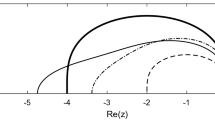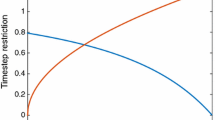Abstract
Strong-stability-preserving (SSP) time discretization methods are popular and effective algorithms for the simulation of hyperbolic conservation laws having discontinuous or shock-like solutions. They are (nonlinearly) stable with respect to general convex functionals including norms such as the total-variation norm and hence are often referred to as total-variation-diminishing (TVD) methods. For SSP Runge–Kutta (SSPRK) methods with positive coefficients, we present results that fundamentally restrict the achievable CFL coefficient for linear, constant-coefficient problems and the overall order of accuracy for general nonlinear problems. Specifically we show that the maximum CFL coefficient of an s-stage, order-p SSPRK method with positive coefficients is s−p+1 for linear, constant-coefficient problems. We also show that it is not possible to have an s-stage SSPRK method with positive coefficients and order p>4 for general nonlinear problems.
Similar content being viewed by others
REFERENCES
Albrecht, P. (1996). The Runge-Kutta theory in a nutshell. SIAM J. Numer. Anal. 33, 1712–1735.
Gottlieb, S., and Gottlieb, L.-A. J. (2001). Strong stability preserving properties of Runge-Kutta time discretization methods for linear operators. SIAM J. Numer. Anal., to appear.
Gottlieb, S., and Shu, C. (1998). Total variation diminishing Runge-Kutta schemes. Math. Comput. 67, 73–85.
Gottlieb, S., Shu, C.-W., and Tadmor, E. (2001). Strong-stability-preserving high-order time discretization methods. SIAM Rev. 43, 89–112.
Hairer, E., Norsett, S., and Wanner, G. (1987). Solving Ordinary Differential Equations I, Springer-Verlag.
Shu, C.-W. (1988). Total-variation-diminishing time discretizations. SIAM J. Sci. Statist. Comput. 9, 1073–1084.
Shu, C.-W., and Osher, S. (1988). Efficient implementation of essentially nonoscillatory shock-capturing schemes. J. Comput. Phys. 77, 439–471.
Spiteri, R. J., and Ruuth, S. J. (2001). A new class of optimal high-order strong-stability-preserving time-stepping schemes. Unpublished manuscript (under review).
Spiteri, R. J., and Ruuth, S. J. (2001). Nonlinear evolution using optimal fourth-order strong-stability-preserving Runge-Kutta methods. Unpublished manuscript (under review).
Author information
Authors and Affiliations
Rights and permissions
About this article
Cite this article
Ruuth, S.J., Spiteri, R.J. Two Barriers on Strong-Stability-Preserving Time Discretization Methods. Journal of Scientific Computing 17, 211–220 (2002). https://doi.org/10.1023/A:1015156832269
Issue Date:
DOI: https://doi.org/10.1023/A:1015156832269




